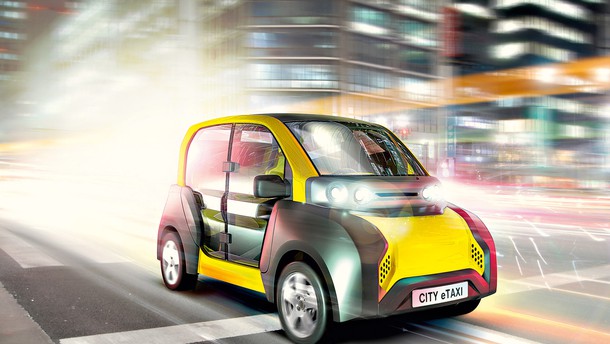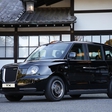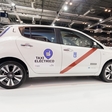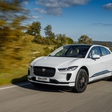
Due to the negative effects of road transport, the European Union recommends the introduction of integrated sustainable mobility plans in extended urban areas with over 100,000 inhabitants. In the White Paper on Transport, one of ten strategic goals adopted by the European Commission is to halve the use of conventionally-fueled cars in urban transport by 2030, and phase them out of cities by 2050, while also achieving CO2-free city logistics in major urban centers by 2030.

Electric vehicles are particularly useful in taxi operations, because cabs are used mainly in the city, and the time spent at the taxi stand can be used for battery charging. A key development to leverage the massive adoption of EV taxis is the existence of a network of fast charging stations, which may allow the batteries of the electric taxis to be charged from 30-80% of their full capacity in just 15 minutes.
Not only are maintenance costs lower than that of ICE vehicles, but also reliability is likely to become a strong selling point for EV taxis, in the eyes of prospective buyers. There are only a few thousand EV taxis in use globally, so it will take more time and miles to reach these goals, but in Estonia, a Nissan Leaf owned by the taxi company Elektritakso has clocked up over 220,000 km on its original battery pack, and Canadian (Quebec province) taxi driver Christian Roy has driven over 100,000 miles (over 160,000 km) on his Tesla Model S 85, while transporting customers to and fro. In cities with a large number of taxis, such as Tokyo, conventionally-powered taxis generate 20% of the air pollution. At the same time, it popularizes the idea of electric transport among the citizens. Electric taxi fleets have been introduced in several cities, and some other cities are introducing or planning to introduce the clean fleet concept, in some cases as a global policy with ambitious precise goals, such as Amsterdam (500 EV taxis today, out of 3000 in total), Beijing (total fleet of 46,000 taxis to be entirely EV by the decade's end), Oslo (1000+ EV taxis today and plans to reach 100% EV taxis by 2023) and, at the forefront of this emission-less taxi trend, New York and London.

The Big Apple´s former Mayor Bloomberg, during his 2013 State of the City Address, called for one-third of his taxi fleet to be electric by 2020, while illustrating the practical benefits of such measure with some figures: replacing one-third of existing taxis with EVs would result in an annual reduction of around 55,000 tons of CO2, an 18% decrease in total CO2 emissions from taxis. It would take the replacement of about 35,000 private vehicles with EVs to realize this level of reduction in CO2 emissions. The same numbers would apply elsewhere. The era of high-class, large, eight-cylinder sedans (in the USA) or diesel-run cars is coming to an end, as is the era of booking your taxi with a phone call.
Those were the golden days for taxi drivers. All it took was a phone call to the taxi dispatcher, who instantly sent an ivory-colored Mercedes-Benz 220d to your door. A grim-faced driver offered to help, if at all, load the luggage, grunted in response to your request to pay with a credit card, and that was all. These days, taxi service in many large cities around the world can be ordered via smart phone application. Numerous countries have even abolished taxis in favor of privately-run transportation companies. In the States, Uber has a long tradition, whereas in China, millions of rides are carried out by the Didi Kuaidi drivers. The former Mercedes sedans in Germany are giving way to more spacious and adaptable MPVs. Also on the rise are hybrid models, while cities including Munich and Hamburg have seen an increase in electric Tesla S sedans. That said, the majority of taxi drivers still rely on diesel engines, with allegedly reasonable fuel economy.
It is only a matter of time before things turn around. Recently, University in Munich introduced a three-seat taxi of the future, which will be trialed as a fleet as early as in 2017. The lightweight City eTaxi was developed by a workgroup with car designers Peter Naumann and Johann Tomforde among its members. Tomforde is known for designing the first generation Smart for Daimler, as well as the smallest cars which bear the Mercedes emblem. City eTaxi is classified as an "Adaptive City Mobility" (ACM) project, entitled to governmental support by January, 2018. The Munich taxi of the future is powered by a 15 kW electric motor, drawing energy from six replaceable batteries with 1.9 kWh capacity. Range: 120 kilometers. Top velocity: 90 km/h on a motorway. "People say that we don't plan to invest much in infrastructure since, sure enough, nobody uses electric cars," says the project initiator, Paula Leibold. "On the other hand, the car owners say that they won't buy electric vehicles, because they're overly expensive and lack infrastructure. The ACM project comes with its own infrastructure, which may resolve the debates about the high price attributed to electric mobility."
A fully-electric propulsion entered the taxi circles in the city of New York, which is currently populated by over 14,000 taxis every day. Instead of the historical Checker-Cabs, thousands of decrepit Ford Crown Victorias sputtering along the well-trodden streets of Manhattan and Brooklyn, the Hybrid Ford Escape is gaining popularity, as is the Toyota Sienna or Camry (also with the electric support). These stand in the way of Nissan's future taxi, a specially-adapted NV200 with a small gas engine that was introduced a few years back, to gain a foothold in metropolises with populations in the millions. The change in the global taxi market is harder to discern in cities such as Tokyo and Hong Kong. The Toyota Crown Comfort, or the historically adorable two-colored and sharp-lined Nissan Cedric, with a design and technology from the 80s, continue to prevail in taxi stands across Asia. In collaboration with the "Japan Federation of Hire-Taxi Associations," Toyota developed a uniquely comfortable taxi for big cities like Tokyo, which will be test-driven for the first time next year. The Japanese capital will also be the testing ground for technology supporting automated driving, designed to help the ever increasing number of taxi drivers,some of them elderly and foreigners, face the daily traffic.

Even in London, the European capital of taxis, nothing is as it once was. For decades, black and dark red taxis traversed the city in their own lanes, rarely subject to change. The statutory provisions ensured that the London Taxi Company retained a nearly complete monopoly over taxis. Having slept through innovation, the company was saved from going bankrupt by the Chinese enterprise, Geely, in 2013. Now the iconic London Black Cab is betting its future on electric motors, just like the founders of the company (London Electrical Cab Co) did back in 1897 (when they ran a fleet of 80 battery-powered cars). The new London TX5 taxis are scheduled to get off the assembly line and hit the Coventry streets in the beginning of 2018, at the latest. Preserving the current design features, the taxis will meet the more rigid environmental regulations in the center of London with a plug-in hybrid electric propulsion.
The current number, 23,000 diesel-powered taxis in London, will eventually be reduced to zero, helping to eliminate almost 10,000 deaths a year on account of smog-related issues.
In the 80s, the Indian businessman, Kamal Siddiqi, started buying various automotive companies. He is the director of the Kamkorp Group, of which Frazer-Nash research powerhouse and Ecotive will start a production of a new Metrocab, competition for the London Black Cab's TX5. "It all began 25 years ago, with go-carts," explains his son, Sheban Siddiqi. What then resembled a storeroom is now bringing to London a nearly zero-emission taxi service. "The important thing is the possibility of upgrade," adds Sheban Siddiqi. The two electric motors in the New Metrocab transfer power to the rear wheels. Driving into a curve, the drive wheels can be controlled independently, thanks to the digital differential. A London taxi has to have a maximum turning circle of 7.6 m, which is allegedly defined by the U-turn space in front of the classy Ritz Hotel. Nothing the New Metrocab couldn't do. At 1400 Nm of torque times two, the supreme propulsion generated by two 50 kW (68 hp) motors comes as no surprise, while the top speed is limited to 130 km/h.

Despite being 4.91 m long and weighing 1750 kg, both of the electric motors are capable of forceful acceleration. The digital differential works well, as is evident in its easy tackling of winding roads. At the end of the day, an important aspect of taxi driving is the drivers' profit. According to Sheban Siddiqi, the E-Metrocab is guaranteed to save its users several thousand pounds each year. With the average fuel consumption of 3.8 l per 100 km, and under 50 g of CO2 emission per km, the new London taxi will beat its predecessor with a 75% decrease in cost. Maximum range: 644 km. The electric motors will be powered by a 12.2 kWh Li-ion battery, while the three-cylinder gas engine will make sure the car doesn't run out of electricity. The battery will take 5 hours to charge and, needless to say, Frazer Nash will also set up solar-powered charging stations. The car has been well-received by the traditionally critical London taxi drivers. For James Sinclair, "this cab is a big leap forward." Others may even delay retiring, to enjoy the opportunity of driving the new taxi. Since London taxi drivers are known for paying little regard to the upkeep of their vehicles, its success will also depend on how reliable its technology is.

The old silhouette is deceptive. Beneath traditionally-adorable bodywork hides modern technology. The air suspension assures comfort, and there's no shortage of space in the passenger's cabin. The battery is mounted under its floor, and the engine is so small that the hood is shorter than before. The new London taxi can take up to six, instead of five, passengers who, despite this fact, have more room than in the previous incarnation of the vehicle. The car is also equipped with a wheelchair ramp. No less comfortable is the driver, who can refer to a virtual cockpit for important information. By contrast, the English-Indian company has ambitions that, by 2018, the traffic in London should be emission-free. That's when Frazer-Nash expects to sell between 3000 and 5000 taxis per year, and later on they hope these numbers to triple. In addition to Great Britain, Asia and Australia, France and Germany represent important markets.
We will see what the Geely Group will do in response. First it has to build its factory, on the outskirts of Coventry.



